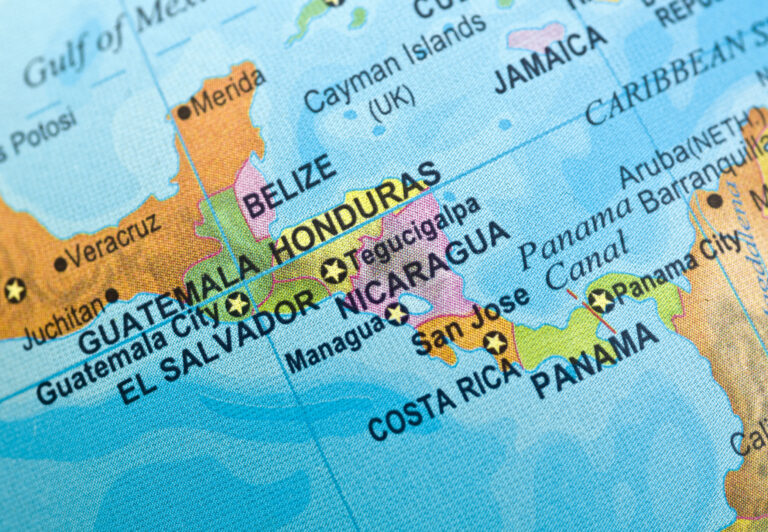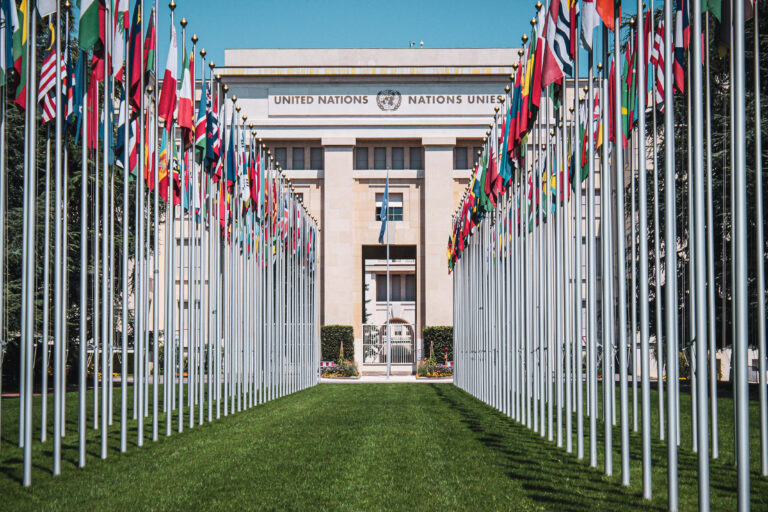For over a decade now, the PRI Review has been the publication of record of the pro-natal movement. We have consistently argued that people are the ultimate resource. We have opposed population control programs that seek to reduce humanity by aborting, sterilizing and contracepting large numbers of people. We have pointed to the damage such programs cause to health care and human rights. For some time I have wanted to bring together in one volume all of the arguments in favor of people, and against artificially limiting human numbers, that have appeared from time to time in the PRI Review. The Introduction in my new book, The War on People, appears in this issue. The remainder will be serialized in the months to come.
For over half a century, the population controllers have perpetrated a gigantic, costly and inhumane fraud upon the human race, defrauding the people of the developing countries of their progeny and the people of the developed world of their pocketbooks. Determined to stop population growth at all costs, the controllers have abused women, targeted racial and religious minorities, undermined primary health care programs, and encouraged dictatorial actions if not dictatorship. They have skewed the foreign aid programs of the U.S. and other developed countries in an anti-natal direction, corrupted dozens of well-intentioned nongovernmental organizations, and impoverished authentic development programs. Blinded by a zealotry worthy of Al Qaeda, they have even embraced the most brutal birth control campaign in history: China’s infamous one-child policy, with all its attendant horrors.
Humanity’s Man-Made Plague
This man-made plague on humanity has caused what it predicted — a world which is poorer materially, less diverse culturally, and which is plagued by incurable diseases (and many curable but ignored ones).
But the controllers have not only studiously ignored the mounting evidence of their multiple failures, they tiptoe around the biggest story of them all: Fertility rates are in free fall around the globe. The world’s population of six plus billion will never double again, but will peak in a few decades at somewhere around 8 billion, and then begin to decline. Sixteen countries already fill more coffins than cradles each year, and the number of dying countries is growing steadily.
The silence of the controllers concerning the coming birth dearth is hardly surprising. Their movement was born in the dark fear of “the unchecked growth in human numbers.” As that phantasm evaporates in the face of falling fertility, so should the population control movement. The trouble is that movements with billions of dollars at their disposal, not to mention thousands of paid advocates, do not go quietly to their graves. Moreover, many in the movement are not content to merely achieve zero population growth, they want to go negative. In their view, our current numbers should be reduced to one or two billion or so, which end would keep them fully employed for the next century or so as they implemented a global one-child policy.
Enough already. If couples around the world are self-regulating their own fertility downward, surely everyone can agree that we don’t need the controllers any more. Perhaps we never did.
The Chinese Model
Li Aihai, happily married and the mother of a 2½-year-old girl, had a problem. She was four months pregnant with her second child. Sihui county family planning officials had come to her home and told her what she already knew: She had gotten pregnant too soon. She hadn’t waited until her daughter was four years old, as Chinese law required of rural couples. The officials assured her that, because her first child had been a girl, she would eventually be allowed a second child. But they were equally insistent that she would have to abort this one. It was January, 2010.1
She pleaded that she had not intended to get pregnant. She was still wearing the IUD that they had implanted in her after the birth of her first child, as the law required. They were unsympathetic. Report to the family planning clinic tomorrow morning, they told her as they were leaving. We’ll be expecting you.
Aihai Fights to Save her Baby
Aihai had other plans. Leaving her little daughter in the care of her husband, she quietly packed her things and went to stay with relatives in a neighboring county. She would hide until she brought her baby safely into the world. Child-birth-on-the-run, it was called.
When the county family planning officials discovered that Aihai had disappeared, they began arresting her relatives. While her father-in-law managed to escape with her daughter, her mother-in-law and brother-in-law were arrested. Her own mother and father, brother and sister, and three other relatives were also imprisoned over the next few weeks. In all nine members of her extended family were arrested, hostages to the abortion that was being demanded of her.
But Aihai, knowing that her family supported her pregnancy, stayed in hiding. And her relatives, each refusing to tell the officials where she had gone to hide, stayed in jail.
Three months later the family planning officials struck again. The date they chose, April 5, was an important one on the Chinese traditional calendar. It was the festival of Qingming, or “bright and clear,” a day on which rural Chinese men, by ancient custom, “sweep the graves” of their ancestors. Starting with the grave of their own deceased parents, they visit in turn the graves of grandparents, great-grandparents, and ancestors even further removed. At each stop they first clean off the headstones and weed the plot, then set out a feast for the deceased, complete with bowls of rice, cups of rice liquor, and sticks of incense.
Why did the family planning officials pick this day of all days? Was it a further insult to the Li family, several of whom were languishing in their jail? Or was the day chosen for a very practical reason: With most of the men and boys away in the hills feting their ancestors, the village would be half-deserted, and they could carry out their plan without opposition.
The family planning officials came to the village in the company of a wrecking crew armed with crowbars and jackhammers. These fell upon Aihai’s home like a horde of angry locusts. They shattered her living room and bedroom furniture into pieces. They ripped window frames out of walls and doors off of hinges. Then the jackhammers began to pound, shattering the brick walls, and knocking great holes in the cement roof and floors. By the time they completed their work of destruction, you could stand on the first floor of Aihai’s home and look up through two stories and the roof to the blue sky above. The wrecking crew then moved on to her parents’ house, and then to her in-laws’. At day’s end, three homes lay in ruins. The family planning officials confiscated the family’s livestock and poultry, then disappeared.
Aihai remained in hiding, out of reach of the family planning officials, for two more months. It wasn’t until her child was actually born, she knew, that he would be safe. Abortions in China are performed up to the very point of partuition, and it is not uncommon for babies to be killed by lethal injection even as they descend in the birth canal. Only after she had given birth — to a beautiful baby boy — did she make plans to return home.
Aihai Returns Home
Aihai came back to find her family in prison, her home destroyed, and family planning officials furious that she had thwarted their will. Underlying their anger was hard calculation: Every “illegal” child born in their county was a black mark on their performance, depressing annual bonuses and threatening future promotions. But family planning officials, like most Chinese officials, have access to other sources of income. If you want your relatives released, they now told Aihai, you must pay a fine of 17,000 Renminbi (about US$2,000). Now this is a huge sum by Chinese standards, the equivalent of two or three years’ income. It was many days before she was able to beg and borrow enough from family and friends to satisfy the officials’ demands, and win her family’s release.
No sooner had she paid one fine than she was told she owed another, if she wanted to regularize her son’s status. He was currently a “black child,” family planning officials explained to her. Because he was conceived outside of the family planning law, he did not exist in the eyes of the state. As a nonperson, he would be turned away from the government clinic if he fell ill, barred from attending a government school of any kind, and not considered for any kind of government employment later in life. He would not even be allowed to marry or start a family of his own. The government had decreed that “black children” would not be allowed to reproduce; one generation of illegals was enough. There was an out, however. If she was able to pay another fine of 17,000 RMB her son would be issued a national identity number, and would be treated like everyone else — almost. She would still be required to pay double fees for his school supplies.
She was not surprised when she was ordered to report for sterilization. The population control regulations, she knew, were unyielding in this regard. Two children and your tubes are tied. This time she made no effort to resist the authorities. Having a second child had bankrupted her family. Having a third was out of the question. Her newborn son would have no younger siblings.
Another Victim’s Story
Even so, Aihai considers herself far more fortunate than Ah Fang, the wife of a neighboring villager. Married at 19 to an older man in a time-honored village ceremony in front of dozens of relatives and friends, Ah Fang is considered by everyone she knows to be his wife. Everyone, that is, but the local Communist authorities, whose unbending family planning regulations prohibit women from marrying until they reach the age of 23.
When Ah Fang became pregnant there was no chance that she would be allowed to carry her child to term, even though it would have been her first. The one-child policy does not apply to couples who are, in the view of the Chinese state, merely cohabiting. For them — and for single mothers of all ages — there is a zero-child policy. Ah Fang was ordered to present herself at the local clinic for an abortion. She went in as instructed on 27 September 2001. She has been careful not to criticize the authorities, but her friends have been less reticent. “She wanted to keep her baby,” they complain openly, “but the law forbids it.”2
These Are Not Rare Cases
Stories of such personal tragedies, far from being rare, could easily be multiplied almost beyond belief. I met many “Li Aihai”s and “Tang Ah Fang”s (the names are, of course, pseudonyms) while living in a village in Guangdong province from 1979 to 1980, and have met many in the years since. But it would be impossible to know them all. For the history of China’s 25-year experiment in “controlling reproduction under a state plan” is littered with literally millions — no, tens of millions — of such victims of forced abortion and forced sterilization.3
At the beginning of 1980, the Guangdong provincial government secretly ordered a 1 percent cap on population growth for the year. Local officials complied the only way they could — by launching a family planning “high tide” soon thereafter to terminate as many pregnancies as possible. The rules governing this high tide were simple: No woman was to be allowed to bear a second child within four years of her first, and third children were strictly forbidden. Furthermore, all women who had borne three or more children by November 1, 1979, were to be sterilized.
Over the next few weeks I became an eyewitness to every aspect of this draconian campaign. I went with young mothers to family planning “study sessions” where they were browbeaten by senior Party officials for getting pregnant. I followed them as they were unwillingly taken under escort to the commune clinic. I watched — with the permission of local officials who were eager to demonstrate their prowess in birth control to a visiting foreigner — as they were aborted and sterilized against their will. I will never forget the pain and suffering etched on the faces of these women as their unborn children, some only days from birth, were brutally killed with chemical weapons — poison shots — and then dismembered with surgical knives.
The Demands Increase
The demands of China’s family planners escalated as the eighties unfolded.4 The one-child policy, first suggested by Deng Xiaoping in a hard-line 1979 speech, was in place nationwide by 1981. The “technical policy on family planning” followed two years later. Still in force today, the “technical policy” requires IUDs for women of childbearing age with one child, sterilization for couples with two children (usually performed on the woman), and abortions for women pregnant without authorization. By the mid-eighties, according to Chinese government statistics, birth control surgeries — abortions, sterilizations, and IUD insertions — were averaging more than thirty million a year. Many, if not most, of these procedures were performed on women who submitted only under duress.
The principal modification of the one-child policy occurred in the mid- to late-eighties when, in response to rising rates of female infanticide, the government relaxed the policy in the countryside for couples whose first child was a girl. In some parts of China this has devolved into a de facto two-child policy. Some rural officials found the selective enforcement of a mixed policy — one child for couples whose first child was a boy, two children for couples who first child was a girl — impossible to manage. Others, including the officials who run Sihui county in Guangdong province, where Li Aihai lives, are doing quite well at giving everyone two chances at a son, but no chance for two sons.
The Horror Continues
A quarter century after the Chinese got deadly serious about family planning, the program continues to be carried out against the popular will by means of a variety of coercive measures. In presenting the program to foreigners, who can be squeamish about such things, Chinese family planning officials are careful to emphasize “voluntarism.” In speaking to their own cadres, however, the only form of coercion ever condemned is the actual use of physical force — tying down pregnant women for abortions, for instance. But while force is frowned upon, it is never punished. Home-wrecking, unlawful detention, heavily punitive lines, and like measures continue to be, as they have been from the late 1970s, the whip hand of the program. Women are psychologically and physically pressured to abort unauthorized children to the point of being dragged to the abortion mill. Networks of paid informants are used to report on unauthorized pregnancies of neighbors, family, and friends. Entire villages are punished for out-of-plan births. Officials conduct nighttime raids on couples suspected of having unauthorized children, and they keep detailed records on the sexual activity of every woman in their jurisdiction — so much for privacy. And to make the coercive regime complete, the “family planning centers” have prison cells — with bars — to detain those who resist forced abortion or sterilization. Forced sterilization is used not only as a means of population birth control, but sometimes as punishment for men and women who disobey the rules.5
The result of this systematic and relentless coercion is that millions of IUD insertions, sterilizations, and abortions continue to be performed each year. The national family planning journal continues to issue thinly disguised injunctions to get the job done at all costs. Officials are exhorted to take “real action” and “effective measures” to achieve “practical results.” In short, Deng Xiaoping’s no-holds-barred approach still dominates the program. “Use whatever means you must [to reduce China’s population],” China’s paramount leader ordered Party officials back in 1979, “Just do it.”6 They have been “just doing it” ever since.
The Chinese government maintains that abuses are the exception, not the rule, and constitute deviations — local aberrations — from national policy. But when the Guangdong provincial government orders 25,000 abortions to be carried out in Huaiji county, as it did in 2001 in response to reports of laxity in the local family planning program, this can hardly be described as a “local aberration.” The Chinese program remains highly coercive not because of local deviations from central policies but as a direct, inevitable, and intentional consequence of those policies.
No Secret in China
This is no secret. Articles in the Chinese media openly speak of the need for coercion in family planning, and senior officials continue to endorse the policy as currently practiced. Chinese Prime Minister Zhu Rongji, for instance, said on 13 October 1999 that “China will continue to enforce its effective family planning policy in the new century in order to create a favorable environment for further development.” (Italics added.) And in its White Paper on Population, released on 19 December 2000, the PRC avows that it will continue the one-child policy for another fifty years. The White Paper actually sets a population target of 1.6 billion people by the year 2050.
Chinese officials, as they have for the past two decades, sought to suggest to the outside world that these targets and quotas will be achieved by “education” and “persuasion,” rather than coercion and compulsion. The velvet tongue, rather than the mailed fist. As an example of the effectiveness of “education” and “persuasion,” the White Paper reported that women were postponing childbirth. While in 1920 they gave birth to their first child at 20.8 years of age, by 1998 they were putting off childbearing until they were almost three years older, age 23.6, to be exact. But this claim is disingenuous. Women are giving birth later in the PRC not because officials have gently whispered in their ears, but because they are strictly forbidden to marry until age 23, and hustled off for an abortion if they become pregnant out of wedlock. Ah Fang would have given birth at 20, had she not been ordered to terminate her pregnancy. As it is, she will be 23 or older when she has her first (and perhaps her only) child.
A Faceless Mass of People
Powerful images of China’s teeming multitudes, dating back to the time of Marco Polo, are scratched deeply on Western minds. The wandering Venetian found much to admire in Cathay’s ancient greatness, civilization and art, but it was the sheer number of Chinese that left him astounded. Skeptical contemporaries gave him the mocking title “Il Milione” for the frequency with which he used this superlative to describe the populations of China’s cities and provinces, the numbers of her civil functionaries, and the seemingly endless ranks of her men under arms.
But Marco Polo was, in this respect, a perfectly reliable witness. The world had never seen a more populous empire than the thirteenth-century Sung Dynasty of his acquaintance. It had a population of some 110 million occupying a continent-sized territory with a standing army of a million. It dwarfed contemporaneous Western states, such as the England of Henry 11, in every respect. Moreover, it had been in existence, counting dynastic interregna, for over 1500 years. China’s population was already 60 million at the time of Christ and reached ever-greater peaks during later dynasties — 80 million in the ninth-century Tang Dynasty, 110 million at the time of Marco Polo’s sojourn, 200 million in the sixteenth-century Ming dynasty, 425 million in the nineteenth-century Ching dynasty. Throughout these long centuries, China’s large population was rightly seen as an indispensable element of its national greatness and imperial power, both at home and abroad.
But there is another, darker Western perception of China’s population, dating back to the Mongol hordes of the non-Chinese Genghis Khan, which sees them “as a faceless, impenetrable, overwhelming mass, irresistible once loosed.”7 And a mass, it might be added, that was thought to be feverishly multiplying. If all of the Chinese people were formed up into a column five abreast, went a cocktail riddle popular in the 1920s, how long would it take the entire column to march past a fixed point? “Never!” was taken to be the correct answer. The column would tum out to be endless, because the Chinese would simply breed faster than they marched. Or so it was wrongly supposed.8 The image of China’s population as a “yellow peril” was brought vividly to life again in the 1950s, when a sea of Chinese flooded across the Yalu River into Korea, and “human wave” attacks were reported by American troops. The lurid and hyperbolical reporting of China’s “overpopulation problem” over the past twenty years arises in part from these same dark fears — and further incites them. In the view of the new Malthusians, China was a boiling pressure cooker of people, who at any time could explode beyond her borders in a human flood of illegal immigration — or conquest.
The controllers welcomed China’s 1979 foray into population control with a mixture of euphoria and relief. Euphoria that the world’s most populous nation was at last getting serious about its numbers. Relief because China would now dam up its seas of people before they could inundate the world. Not that they were content to stand idly by while the Beijing regime put the fix on one-fifth of humanity. No, they would roll up their sleeves and pitch in. They would help the design and implement a program that would tum China, everyone’s brutish infant of overpopulation, into a poster child of family planning. China would become a model for other countries. Depressing the birth rate in China — important in itself — would help them to further depress birth rates worldwide. It would move the controllers at the United Nations Population Fund (UNFPA) and elsewhere that much closer to their global goal, as stated by UNFPA Executive Director Nails Sadik, of “achieving the lowest level of population in the very shortest time.”9
Violation of Rights
No one stopped to think about China’s abysmal human rights record. No one expressed concern that the Chinese government, in dictating how many children a couple might have, was violating parental rights. No one worried that, in enforcing the one-child policy, the government might resort to coercion, as it had done in past political campaigns. Everything — economic development, democracy, and even human rights — would have to await the taming of her numbers.
Acting as if they were afraid that the Beijing regime might change its mind, the controllers hastily began helping to fund it. The largest grant came from the UNFPA, which would quickly become the major player in China; it ponied up a hefty $50 million over five years. The International Planned Parenthood Federation (IPPF) signaled its approval with a much smaller, but still significant, grant of $500,000. Other grants followed.
Praise for Population Control
Having funded the China program, population control advocates were soon chanting its praises, acclaiming its achievements, and even expressing approval of many, if not all, of its methods. The United Nations picked 1983, a year of unusually severe coercion inside of China, to present the first United Nations Population Award to the PRC. The decision was criticized in many quarters, and the respected American Nobel Laureate Economist, Theodore W. Schultz, immediately resigned in protest from the UN Population Award advisory commission, but the UN was undeterred. As a family planning “high tide” ripped through the Chinese countryside, UN officials in solemn ceremony lauded China “for the most outstanding contribution to the awareness of population questions.”10 That same year the International Planned Parenthood Federation (IPPF) welcomed the Chinese Family Planning Association to full membership in the Federation, declaring the goals of the Chinese program entirely consistent with its own.11 One wonders what the approximately 15 million young Chinese women who were aborted that year, perhaps 90 percent under coercive circumstances, thought of such accolades.
Exporting the China Model
Talk of exporting the China model had already surfaced. Werner Fornos of the Population Institute, a fringe group closely tied to the UNFPA, declared in 1982 that the Chinese program was one that “the world should copy.”12
As the eighties progressed, the trickle of reports about coercion in China became a flood. Michael Weiskopf of the Washington Post published a series of articles on the one-child policy which brought home to people in our nation’s capital the human cost of the program.
Little doubt was left in the minds of reasonable people that China’s population control program was synonymous with coercion.
For my part, I published a best-selling book on rural China called Broken Earth, appeared on 60 Minutes and other television shows, and lectured around the country, reporting on the forced abortions and sterilizations that I had witnessed.13 Many people shared my outrage at these crimes, but I found the reaction of others strangely muted. Some in Congress and in the media, I was disappointed to find, were all too ready to excuse these acts in the name of fighting “overpopulation.” As one of the leaders of the National Organization of Women put it to me, “I am personally opposed to forced abortion and sterilization but, after all, China does have a population problem.” Others, sounding for all the world like the Chinese Communist Party officials I had interviewed in China, openly argued that, because China was a poor country, its people could not be allowed to have as many children as they wanted. A number actually applauded the Chinese model, and wanted to use it as a blueprint for other countries. “Limiting everyone to one child, even in the U.S., was a good idea,” one said to me.
What I had thought was an open-and-shut case — who would defend the forced abortion of a woman eight months pregnant? — —ad turned out to be an open question, at least in the minds of some. A wild-eyed professor at California State University at San Luis Obispo, became angry with me for even suggesting that moral considerations should enter into the equation. “Don’t you see that the Chinese government must control childbearing under a state plan in order for China to develop!” he shouted in front of the 800 faculty and students who had gathered for my lecture. Lurking behind his utilitarian obtuseness was the misguided belief that the Chinese people in their numbers were the chief obstacle to China’s prosperity.
Praise and Funding
But nothing could match the enthusiasm of the professional population control movement. Their earlier actions — in praising, awarding and funding the program — had turned them into collaborators in the abuses that followed. Having praised and funded the program, they lacked the moral authority to criticize its shortcomings, even in private meetings with Chinese officials. But they really didn’t seem to care. As long as China was “doing something” about its “overpopulation problem,” they were on-board. Many, like the head of the Population Council, Bernard Berelson, had long wanted to go “beyond family planning” to massive government intervention to force down fertility.14 China was to be applauded, not condemned, for coming to grips with its population problem.
Denials of Abuses
Parroting Chinese official denials, the controllers dismissed reports of forced abortions as “local aberrations” or, more commonly, refused to acknowledge them at all. Nor were they concerned that the one-child policy ran roughshod over traditional values and human rights. They rarely referred to the family planning “high tides” which periodically gripped the country. They avoided mentioning the “mass mobilizations” in which women are rounded up against their will to have IUDs inserted, undergo abortions, or be sterilized.15 They turned a blind eye to the severe punishments visited upon women, like Li Aihai, who evaded the mandatory “surgeries,” and bore children without government permission. What was important to them was that it was efficient, like Mussolini’s trains.
Population Number Fixation
China had taken a page out of their own playbook. How could they condemn China for actually doing what they had long advocated? Of course it was necessary for them to avert their eyes from the resulting carnage. It was too painful to watch. They had never thought through the political implications of what they were advocating or its possible cost in other important human values, They had been fixated by the numbers, like Dr. Richard Cash of the Harvard School of Public Health. After congratulating China’s State Family Planning Commission on having “a very strong family planning program for many years,” Dr, Cash urged China and its foreign supporters to continue their “very good work” and not allow the Chinese “people to slip back into having larger families.”16 The numbers were the thing. As long as births in China were headed in the right direction — namely down — what did it matter how it was done?
Strange Defense
The more criticism of the one-child policy grew, the more its foreign supporters rallied to its defense with a strange combination of threats and denial. Some warned darkly that other countries, if they could not get their birth rates down by voluntary means, would soon have to adopt compulsory family planning. Some singled out countries like India where the Chinese model should be adopted immediately. The denial crowd was led by UNFPA head Nafis Sadik, who made headlines in 1989 when she informed a CBS reporter that “the implementation of the policy [in China] and the acceptance of the policy is purely voluntary. There is no such thing as, you know, a license to have a birth and so on.”17 [italics added]
It is uncertain whether Sadik actually believed this. Chinese officials are of course at pains to reassure every Western visitor that the one-child policy is “purely voluntary,” but every Chinese alive understands that the state has assumed regulatory power over reproduction. The state-run media regularly warns couples that they are not free to have as many children as they would like, as when the Jilin provincial newspaper in October 1993 reported that, according to the provincial birth control regulations, married couples “cannot voluntarily have children unless they obtain a child-bearing license.”18 (Italics added.)
Editor’s Note: Next month’s Population Research Institute Review will carry the second part of the introduction to The War on People, including details on the main points of how the China Model of population control works, China today and UNFPA’s involvement not only in China, but its attempts to export the process to other Third World countries. It will be the second in a number of future issues where you will be able to read excerpts from Steve’s latest book.
Endnotes
1 Josephine Guy, “Story of a Beautiful Baby Boy,” PRI Review 11:4 (Sept-Oct 2001), pp. 8–9
2 Quoted in Josephine Guy, “Women and Child Abuse in China,” PRI Review 1:4 (Sept-Oct 2001), p. 3.
3 The quote comes from Vice Premier Chen Muhua, who said in 1979 that “China is a socialist country. We should be able to control reproduction the same way that we control production under a state plan,” See my Broken Earth: The Rural Chinese (Free Press: New York, 1983).
4 I have made periodic trips into China to assess family planning policies, have commissioned others to undertake such investigations, and have closely followed both official Chinese pronouncements and reports appearing in the specialized literature and the population press.
5 See the testimony of Gao Xiaoduan who, as a senior population control official in Fujian province, had systematically committed these and other abuses of human rights with the encouragement and support of her superiors. Following her escape from China, Mrs. Gao was invited by Cong. Christopher Smith (R-NJ) to testify before the Subcommittee on International Operations and Human Rights of the International Relations Committee. Gao Xiaoduan. “Forced Abortion and Sterilization in China: The View from the Inside,” Subcommittee on International Operations and Human Rights, 10 June 1998. Also see my book, A Mother’s Ordeal: One Woman’s Fight Against China’s One-Child Policy (Harcourt Brace: New York, 1993), for similar abuses.
6 John Aird, Slaughter of the Innocents.
7 Harold R. Isaacs, Scratches on Our Minds: American Images of China and India (New York: John Day, 1958), pp. 63–64. Also quoted in my China Misperceived: American Illusions and Chinese Reality (New York: Basic Books, 1990), pp. 18–19.
8 Calculate the rate of march, the rate of reproduction, and the time it would take for the complete column, including babies born during the march, to pass under the arch.
9 The quote is from Nafis Sadik, the former Executive Director of the UNFPA, as quoted in Nicholas Eberstadt. “UNFPA: A Runaway Agency,” PRI Review 12:3 (May-June 2002), p. 8.
10 The respected American Nobel Laureate Economist, Theodore W. Schultz, resigned in protest from the U.N. Population Award advisory commission over the decision to reward China for coercion.
11 “Guojia jihua shengyu lianhehui Wu Kunhuang he Aluweihaier zhuren shuo: renmin xuanze Zhongguo de jihua shengyu shi renmin zijide xuanze” (“President Ng Khoon-Fong and Director Aluvihare of the International Planned Parenthood Federation say that China’s family planning program is the people’s own choice”), Jiankang bao (Health Gazette), Beijing, 18 April 1983, p. l.; and “Family planning measures hopeful,” China Daily, Beijing, 4 May 1983, p. 3. Cited in John Aird, “The China Model,” PRI Review 4:4 (July-August 1994), p. 1.
12 “China Daily wins global media award,” China Daily, Beijing, 16 March 1982, p. 3. Cited in John Aird, “The China Model,” PRI Review 4:4 (July-August 1994), p. 1.
13 See, inter alia, my Broken Earth: The Rural Chinese (New York: The Free Press, 1983), esp. Chapter 8.
14 Berelson, who headed the Population Council, from 1968 to 1974, thought that the population crisis was so severe that “forced-pace measures” were necessary. In his article, “Beyond Family Planning,” he proposed that government intervention was the only answer. See PRI Review 4:5 (September-October, 1994), p. 11.
15 John Aird, “The China Model,” PRI Review 4:4 (July-August 1994), p. 1. “
16 See “A Peoples’ Project in China,” JOICFP News, no. 234, December 1994, p. 6, as quoted in the PRI Review 4:2 (March-April). p. 7.
17 Quoted in Christopher Smith, “Judging a Civilization,” PRI Review 11:4 (September-October 2001), p. 3.
18 “Several regulations of Jilin province for the administration and management of family planning,” Jilin Ribao, Changchun, 29 October 1993, Joint Publications Research Service, no. 94010, 10 February 1994, pp.19–20. Cited in John Aird, “The China Model,” PRI Review 4:4 (July-August 1994), p. 3.










